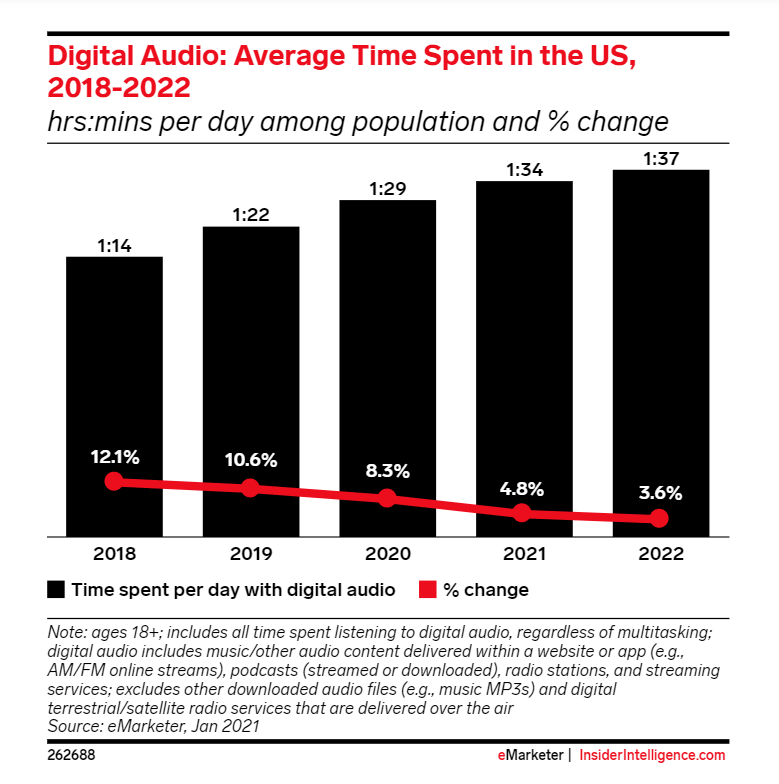
In new data from eMarketer, we learn that digital audio continues to grow even in the wake of a global pandemic. And by grow, they mean that the time users spend listening to this type of content continues to increase. Early in the pandemic, this didn’t necessarily look like it would be the case, as homebound consumers turned to traditional TV or social media (or both) leading many researchers to suggest digital audio would lose some ground.
See what happened with digital audio during the pandemic…
Many market researchers, including eMarketer, had predicted that digital audio would be hit hard by the pandemic. Why would they think that? Because conventional wisdom had it that most users enjoyed listening to this kind of content during their commute to/from work. With everyone housebound, the thought was that other forms of entertainment would gain their attention. There was some early-in-the-pandemic indication that this might be the case. But as time went on, researchers discovered that digital audio turned out to be more resilient than they originally expected.
So the definition of digital audio for the purposes of this research was, “music/other audio content delivered within a website or app (e.g. AM/FM online streams), podcasts (streamed or downloaded), radio stations, and streaming services; excludes other downloaded audio files (e.g. music MP3s) and digital terrestrial/satellite radio services that are delivered over the air.”
Continuing to Gain in Popularity with Users
Up until 2020, digital audio has been quickly growing in popularity with consumers. Back in 2018, I wrote about a Nielsen study that tied the spectacular growth of digital audio listening with the growing use of smartphones. It was really good to see consumers enthusiastically consuming audio…kind of like an audio renaissance.
Separately, eMarketer has also been conducting surveys and studying trends in digital media – in their case focusing on the rapid growth in time spent by users listening to various forms of digital content. Early in the pandemic, it looked as though users were turning to more traditional media, such as TVs and social media. Still others focused on digital video and gaming. This led eMarketer to revise their forecast suggesting that the time spent with digital audio would actually decline by 1.0%.

Stalled in the 1st Half, Consumption Takes Off in 2nd Half
But then the trend changed during the rest of 2020, and eMarketer (as well as others) was forced to revise their revision from a -1.0% decline to 8.3% growth – for a total of 1 hour, 29 minutes per day. And while this new rate was, as eMarketer put it, “a deceleration from digital audio’s strong growth rates in recent years,” it was only a slightly off of the 2019 pace of 10.6% increase in time spent.
When you consider how different 2020 was compared to 2019, it is easy to understand why researchers forecasted reduced time listening to digital audio. Everyone was working remotely, quarantined in their homes. Their only commute was the few feet inside their home from their kitchen to wherever they had set up their office. With many people listening to digital audio typically on their commute, there was bound to be a reduction in hours spent with with this content now that they were, essentially, commute-less.
Back to It ‘With Gusto’
As the months went by, eMarketer said, “consumers gravitated back to digital audio with gusto.”
Interestingly, the market researcher noted that patterns and preferences in consuming digital audio changed during 2020 with most Americans working and learning from home. Popular apps like Pandora and Spotify said their data showed more users consuming via smart speakers and smart TVs. Also, time-of-day consumption patterns changed as well, with weekday consumption taking on the characteristics of past weekend consumption.
The data also captured the growing popularity of podcasts with an “unexpected spike in popularity, as long-form audio engagement became easier to undertake at any given time of day.”
Users Will Continue to Increase Their Listening Time; A 2021 Milestone
Digital audio consumption is expected to continue to increase, from 1:29 in 2020 to 1:34 in 2021 to1:37 in 2022. The study also identifies what it calls “active” listeners of this content, whom they say are more enthusiastic users of the format. The survey shows these active listeners spent a full two hours and five minutes (2:05) per day enjoying digital media in 2020. And eMarketer says this number will jump another 5 minutes in 2021.
The study also determined that 70% of U.S. adults listened to digital audio content at least once a month in 2020. And 91.7% of them consumed that content via mobile.
Finally, the study has determined that digital audio will hit a key milestone this year. They have determined that in 2021, 50.8% of U.S. adults total audio time will be spent listening via digital services. This is the first time ever that digital audio surpasses traditional radio in time spent.
For more information on this and other research, visit: emarketer.com.











[…] 2020, the time U.S. adults spent with digital audio grew 8.3%. They spent nearly 90 minutes with digital audio per day. Digital audio apps such as Spotify and […]